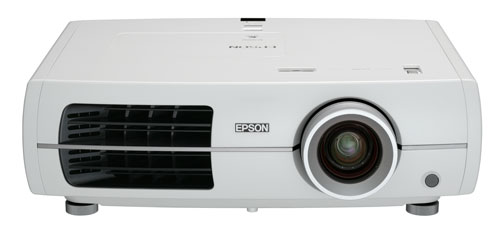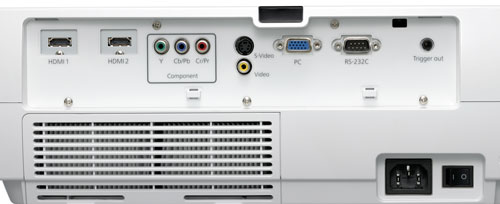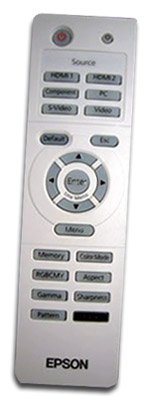When my editor told me I had to come up with a "clever title" for this review, the above quote from "Crazy People" -- actually a potential ad for Volvo submitted by Dudley Moore's character in the film -- seemed just about right. The Epson PowerLite Home Cinema 6500 UB may not be the sleekest model in the showroom, but its performance makes up for that in spades. But I'm getting ahead of myself. First some background...
As it is for many gear reviewers and tech scribes, being a writer is a second job for yours truly – it's a passion... a secret identity, if you will. (Never fear, Roving Reporter is here! Batman, eat your heart out.) And for this full-time software developer, Monday through Friday involves occasional trips to the office, donning the suit and tie and holding meetings with the boss.
Imagine my surprise when, during a recent trip to the office, I learned that my other boss is currently shopping around for a new projector. He's intrigued by the thought of owning a 3-chip DLP unit, but they're just "so damned expensive." And he's absolutely right. The thing that surprised me though was his need for an insanely bright machine -- "at least 2500 lumens" he said. "Why so bright?" I asked. As it turns out, he's recently gotten rid of all of his televisions and his front projection rig is now the only display in his house. As a result, he needs a light cannon -- something for day or nighttime use with plenty of tolerance for ambient light.
Like most projectors designed for a dedicated home theater, Epson's PowerLite Home Cinema 6500 UB probably isn't going to work for him, unless he has a super high gain screen. However, that doesn't change the fact that the 6500UB -- rated at a whopping 1600 ANSI lumens -- is one of the brightest projectors I've ever laid eyes on. And it comes with a price tag that's well short of even the "entry level" 3-chip DLP models. In fact, this versatile 3-chip LCD projector (aka "3LCD" design) rings up at less than the cost of many single chip DLP projectors, without all the performance sacrifices inherent in a single-chip design.

Outside the Box
Unlike previous generation models such as the 1080UB, Epson's latest crop of PowerLite Home Cinema projectors forego curvaceous sex appeal opting instead for a boxy, all-business, even "Volvo-like" exterior. They've also put on a bit of weight, with the 6500UB tipping the scales at more than 16 pounds. This is due in part to a larger overall footprint, a beefier and brighter 200-watt lamp plus a new Fujinon lens system. Though not unattractive, the 6500UB isn't going to be hanging out with a posse of anorexic supermodels.
On the generous rear of this model (ahem), you'll find that the 6500UB is well equipped to satisfy the majority of your connection requirements. Leading off, you get two HDMI 1.3b ports and one set of component video inputs. Although most consumers are apt to pair the 6500UB with an A/V receiver equipped with HDMI switching, I would gladly give up the composite and S-video jacks in exchange for an extra HDMI port or two. A second component video input wouldn't be unwelcome either. But I guess Epson wants the projector prepared to take on all comers, both standard def and high def alike. Rounding out the jack pack, you'll find a VGA (DB15) computer input, an RS-232C port plus a 12-volt trigger output for remote automation systems.
Like the projector, the remote control supplied with the 6500UB has done away with the rounded edges of yesteryear and in their place we get hard edges and rectangular (albeit backlit) buttons. Although I'm not a huge fan of the new remote design, it did gradually become comfortable throughout the duration of my evaluation. The large, clearly-labeled, source buttons make switching inputs refreshingly simple and the central cursor controls are ideally located and easy to use. The bottom button cluster struck me as a bit random and I would have liked to have seen the "Aspect" button better segregated for quick use in the dark. And while we're making wish lists, how about a "Last" button for instant access to the last "Picture" or "Signal" setting you adjusted? That would be handy, wouldn't it? I'm just saying.
Focus!
Setting up the 6500UB was quite simple thanks to the unit's generous 2.1x zoom lens and the presence of both horizontal and vertical lens shift controls. The lens shift was about as good as it gets at nearly twice a full screen in height and almost a full screen width in overall adjustment. It should be noted that both zoom and lens shift are manual adjustments, so those looking to ceiling mount in a hard-to-reach area would probably do well to consider other options if you need regular access to the zoom and lens shift controls. Also, note that the 6500UB's air intake is on the back side, so a rear wall shelf-mount may not allow for adequate ventilation.

Using both BetterCables and Monster component video cables (and later a BetterCables HDMI cable), I connected the 6500UB to my Panasonic DMP-BD35 Blu-ray player and Panasonic RP-91 DVD player. To see all the pretty pictures, I pointed the 6500UB at my reference screen: a white, 92-inch Carada "MMS Series" complete with Carada's Masquerade horizontal masking system.
Before calibrating the 6500UB, I spent several evenings just taking in the projector's out-of-the-box performance. In a word? Excellent. Although the lamp was cranking way too bright for my dark basement and the image was somewhat bluish, the default picture was still highly respectable. That said, if you're going to drop all that money on a high performance 1080p projector, to not perform a full grayscale and color calibration would be, well, daft.
After roughly 40 hours of lamp use, I conducted a full calibration using my SpyderTV PRO 2007 colorimeter and color analyzing software. Although I'm ISF-certified and I've sat for the 5-day course, calibrating displays isn't my livelihood so I haven't invested in the hardcore colorimeters or other tools the pros use. I like the SpyderTV PRO because it's relatively quick, it's easy-to-use and it gets me significantly closer to perfection than does the naked eye and a copy of Digital Video Essentials.
The 6500UB has several color modes to choose from. In a darkened room, Theater Black 1 or 2 are your best options. I opted for the former and then set about disabling the auto-iris, frame interpolation and noise reduction features. On the subject of the auto-iris, it should be noted that even in "High Speed" mode, I found the iris' adjustment noise to be a tad irksome. It probably didn't help that I had the projector directly above my head, but it's worth pointing out all the same. I left the auto-iris off during calibration and never felt compelled to re-enable it.
To reduce eye strain and fan noise, I changed the lamp setting to its low/economy mode. (My aforementioned boss definitely wouldn't want to do this, at least not during the day, but it's recommended for the average cave dweller.) After testing each of the color temperature pre-sets, the 7500K option brought me closest to the 6500 Kelvin target for white. Adjusting the cuts and gains, I did have to reduce blue and red quite a bit, but eventually got everything dialed in rather nicely. Ramp test patterns revealed solid grayscale tracking and Datacolor's before-and-after images showed blacker, more detailed shadows and no apparent white clipping on the upper end of the spectrum.
Roll Tape!
After a promising calibration, I was eager to see how the 6500UB tackled the Silicon Optix HQV Benchmark discs and real world viewing material. I figured the 6500UB would have zero trouble with the HQV discs on account of its built-in HQV Reon-VX video processor and PixelWorks 390 scaler. As it turns out, things didn't go exactly to plan. (What fun would that be, right?)
Starting with the HQV Benchmark DVD, I had my Panasonic RP91 output a 480i signal over component video. All of the most important tests passed just fine, but the "Jaggies" tests weren't the slam dunk I was expecting. Test #1 (a revolving bar within a circle) was a solid victory but Test #2 (three bars within a circle moving together) had the third/lowest bar exhibiting more movement than I would have expected. I would still grade it a pass, but I've definitely seen better. The same was true for the race car sequence, which tests for 2:3 cadence pickup; grading on a pass/fail basis the 6500UB earned a pass, but the grandstands had considerably more shimmer than I expected to see. Things improved when I popped the Benchmark high def Blu-ray Disc into the DMP-BD35 and evaluated a 1080i signal. The high def "jaggies" tests didn't cause nearly as much concern and overall the 6500UB passed all of the high definition de-interlacing tests with flying colors.

Watching numerous Blu-ray clips from The Fifth Element, Harry Potter and the Goblet of Fire and the dopey-but-fun Fast and the Furious: Tokyo Drift, I was utterly blown away by the sheer depth, detail and color palette put forth by the 6500UB. Tokyo Drift, like its predecessors, is a colorful film but the 6500UB took things to a whole new level. Skin tones appeared blissfully natural and the fire engine red Viper from the film's opening sequence completely popped against its dusty backdrop.
On a final HD performance note, I should mention that the 6500UB does feature a 120Hz Frame Interpolation mode, which Epson has dubbed "FineFrame." I don't recommend it. Like similar technologies found on other projectors and flat panels, the "enhanced" image takes on a somewhat artificial look (some would say "video-like") and the result is somewhat disconcerting. It's a bit hard to explain and like the Matrix, you really have to see it for yourself. Once you do, I think you'll agree that it's best to leave Frame Interpolation turned off.
For movie purists, the 6500UB has a 4:4 pulldown mode, which is engaged by default on 24 frame per second (FPS) sources. This mode presents film motion at an exact multiple of 24 Hz - 96 Hz to be exact - for what many consider the most accurate rendition of film motion. For 1080/24p source signals, you can engage either 4:4 pulldown or Frame Interpolation (FI) or neither, but not both. Frame Interpolation in this scenario is also carried out at 96Hz rather than the usual 120 Hz.
I watched the opening moments of The Dark Knight seven or eight times, experimenting with the three permutations: 4:4 engaged and FI off; 4:4 off and FI off; 4:4 off and FI engaged. As with a 60Hz input signal, Frame Interpolation on a 1080/24p signal introduced significant artifacts especially during fast motion - and gave everything that disconcerting "Live News" feel. With FI safely in the OFF position, I was unable to detect a difference between having 4:4 engaged versus not, so I left left it on for most of my viewing.
Standard definition performance was continued good news. Whether it was watching the DIY channel on my DISH Network ViP722 or the coliseum flyover on the Gladiator DVD, visual artifacts were kept to a minimum. If you have to watch standard definition material, the 6500UB is definitely going to help make the best of things, without having to pay extra for an outboard video processor.
Turn-Ons:
Turn-Offs:
Final Thoughts
Epson's 6500UB may be boxy, it may be a tad heavy and its frame interpolation mode may not be quite ready for prime time, but that's not going to stop me from calling it a remarkable performer. You'll notice I didn't tack "for the money" onto the end of that sentence. Yes, at less than $3,000 the 6500UB represents a fantastic value in the front projector marketplace. However, its bright and beautiful video performance -- particularly with 1080p/24Hz source material -- puts the 6500UB in the top echelon of current 1080p projectors. Period.
Where to Buy:
Specifications from the Manufacturer:
Manufacturer's Contact Information:
Epson America, Inc.
3840 Kilroy Airport Way
Long Beach, CA, USA 90806
Telephone: 1-562-981-3840
Fax: 1-562-290-522
On the Web: www.epson.com
| Overall | |
|---|---|
| Value | |
| Performance | |
| Features/Ergonomics |